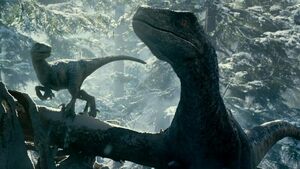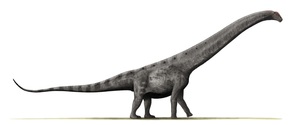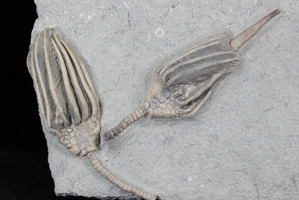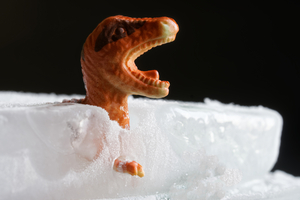Why Did The Megalodon Shark Go Extinct?
The Megalodon Shark (Otodus megalodon) is quite possibly one of the most famous prehistoric animals that ever lived, aside from the dinosaurs. Its supreme size, massive maw, and titanic teeth have captivated both those who love sharks and those who find them utterly terrifying. But where has this whale-eating sea monster gone, and why, if it was so successful, did it die out so completely.
The Megalodon was a massive Otodontid shark which lived around 15 million years ago to somewhere between 4 and 1.5 million years ago, during the Miocene and Pliocene epochs of the Cenozoic era. It lived in warm waters throughout the Earth’s oceans, seemingly not limited much in habitat. It was one of the apex predators of its time, and was highly successful, judging by the seemingly uncountable quantities of adult megalodon tooth fossils found worldwide to this very day.
It fed on medium sized baleen whales, which were more numerous than today, owing to the warmer climate of the Miocene. The warmer temperatures are part of why Megalodon was able to survive and thrive at the time, warm ocean temperatures aid in biodiversity, which in turn can sustain larger animals with higher metabolic demands. As a shark exceeding 50 feet in length, the Megalodon would have required massive prey animals to survive.
The exact point of extinction has shifted over the years as more data has become available. Some studies place the megalodon’s extinction relatively close to the present, about 2.6 million years ago, while a 2019 study places a 800 thousand year range between 4 and 3.2 million years ago, with a median extinction range about 3.5 million years ago. No Megalodon fossils that have been found have been confirmed to date beyond the Pliocene-Pleistocene boundary (approx. 2.6 million years ago).
However, today, the Megalodon is decidedly extinct. No more does the bane of Miocene mysticetes roam the oceans it once called home. Why is this? There are, like most extinctions, numerous factors which lead to the downfall of this, the most massive of sharks.
Climate change is thought to have certainly played a role in the extinction of the Megalodon. The global temperature of the Miocene was higher than today, but fell to temperatures close to our “normal” shortly into the Pliocene epoch. Megalodon, like most mackerel sharks, was most at home in these tropical conditions. Fossil remains suggest that historically colder waters had a much lower Megalodon presence, if any existed there to begin with.
As stated previously, temperatures fell as the Earth moved into the Pliocene. This was due to a number of factors, but one of them was lowering sea levels and a closing of the Central American Seaway towards the end of the Miocene. This dramatically changed ocean currents, meaning that warmer water was not able to make it all the way to the poles and preserve a warmer temperature worldwide. As sea levels lowered, more seawater also became locked up as polar ice, which further lowered global temperatures, and was part of the movement towards the ice ages that so defined the Pliocene and Pleistocene.
Fossil evidence suggests that Megalodon was a mesotherm, that is to say, an animal that could regulate its body temperature to some extent, but not to the level that an endothermic animal like a mammal could. This is also known as regional endothermy, as the Megalodon was able to adjust its body temperature based on the different regions of its body, similarly to modern lamnid sharks, which suggests a correlation between these adaptations and a lifestyle of active predation.
It is thought that because of this, the Megalodon may have been able to endure colder temperatures. If this is the case, then the importance of climate change in the extinction of the megalodon may have been less directly causal as the indirect effects of the cooling oceans and closing of seaways.
Megalodon wasn’t the only creature in the seas affected by the shrinking of the seas and separation of the Atlantic and Pacific by Central America. Those mid-sized whales it fed on also found difficulties in the changing climate. Of the 20 genera of mysticetes (baleen whales) that were known to have existed at the time, only 6 have surviving lineages today, and most of them reach much larger sizes than they did during the Miocene.
For a huge shark like Megalodon, dwindling food supplies would have been devastating. It already had to compete for these prey animals with large macroraptorial sperm whales like Livyatan melvillei and Zygophyseter, mammals better suited for changing climates but equally unprepared for the disappearance of the mid-sized baleen whales.
Around this time, the earliest ancestors of modern Orcas, as well as contemporary Great White Sharks were starting to see greater habitat expansion. Additionally, the surviving mysticete families saw an evolutionary trend toward gigantification, likely an adaptation for the cooling trends that characterized the time. With much of its food supply gone, the next best prey animals were too large to hunt, in the case of the large baleen whales. Smaller prey, like smaller toothed whales, were too fast to hunt, and would have been in more danger from both smaller sharks such as Great Whites as well as the newly evolved Orca whales, leaving the Megalodon outcompeted.
In addition to all this, Megalodon was thought to have made nurseries in coastal lagoons during the warm period of the Miocene. These shallow areas would have been safe and warm for baby and juvenile Megalodons to reach sub-adult sizes before venturing out into the open ocean to hunt for prey as adults. With the lowering of sea levels, these lagoons would have shrunk in size and number, leading to a very dangerous environment for any baby Megalodons trying to grow up in a rapidly changing world.
The end of the Megalodon was an effect of the dramatic shift in global ocean ecologies that was kickstarted by the climate changes of the Miocene-Pliocene boundary. The extinction of such a successful apex predator created a cascade of ecological effects.
With the large oceanic superpredator niche opened up, large predatory sharks and cetaceans filled the space that was left. The earliest Orcas arose in this time, and are one of the most successful polar and subpolar predators in the world, feeding on fish, sharks, and marine mammals. Toothed whales took up other niches as well, with the living Sperm Whale becoming specialized for feeding on large soft-bodied squid, while dolphins and sharks compete as the dominant piscivores. Fossil evidence shows that in areas where Megalodon disappeared, white sharks began to appear in greater numbers.
The remaining mysticetes, the baleen whales, were trending towards gigantism as the Megalodon trended towards extinction. The smallest baleen whale alive today is the Minke whale, at 20 ft (6m), but the largest, the Blue Whale, is over 100 feet (32m) in length, and at over 200 tons is the largest animal to have ever lived. It is likely that the absence of large predators like Megalodon and Livyatan melvillei helped the surviving mysticete genera reach the gigantic proportions they are known for today.
Some people today are insistent that the Megalodon is still alive, for a myriad of unlikely and downright impossible reasons. The Megalodon is not surviving on paltry scraps at the bottom of a freezing cold undersea trench, or in some uncharted sector of the open ocean. It was a coastal apex predator that routinely came close to shore to both feed, breed, and rear their young. If any Megalodon lineages survived to this day, they would have changed drastically, and if they hadn’t, we would certainly have evidence for a 50 foot shark that feeds on whales. The fact of the matter is that we simply do not have such evidence, because the Megalodon is most certainly extinct.
Pimiento, C.; Griffin, J. N.; Clements, C. F.; Silvestro, D.; Varela, S.; Uhen, M. D.; Jaramillo, C. (2017). "The Pleistocene Marine Megafauna Extinction and its Impact on Functional Diversity". Nature Ecology and Evolution. 1 (8): 1100–1106.
Boessenecker, R. W.; Ehret, D. J.; Long, D. J.; Churchill, M.; Martin, E.; Boessenecker, S. J. (2019). "The Early Pliocene extinction of the mega-toothed shark Otodus megalodon: a view from the eastern North Pacific". PeerJ. 7: e6088.
C.; Clements, C. F. (2014). "When Did Carcharocles megalodon Become Extinct? A New Analysis of the Fossil Record". PLOS ONE. 9 (10): e111086.
Deméré, Thomas A.; Berta, Annalisa; McGowen, Michael R. (2005). "The taxonomic and evolutionary history of fossil and modern balaenopteroid mysticetes". Journal of Mammalian Evolution. 12 (1/2): 99–143.
Bianucci, Giovanni; Walter, Landini (2006). "Killer sperm whale: a new basal physeteroid (Mammalia, Cetacea) from the Late Miocene of Italy". Zoological Journal of the Linnean Society. 148 (1): 103–131.
Lambert, O.; Bianucci, G.; Post, P.; de Muizon, C.; Salas-Gismondi, R.; Urbina, M.; Reumer, J. (2010). "The giant bite of a new raptorial sperm whale from the Miocene epoch of Peru". Nature. 466 (7302): 105–108.
Pimiento, C.; MacFadden, B. J.; Clements, C. F.; Varela, S.; Jaramillo, C.; Velez-Juarbe, J.; Silliman, B. R. (2016). "Geographical distribution patterns of Carcharocles megalodon over time reveal clues about extinction mechanisms". Journal of Biogeography. 43 (8): 1645–1655.
Boessenecker, R. W.; Ehret, D. J.; Long, D. J.; Churchill, M.; Martin, E.; Boessenecker, S. J. (2019). "The Early Pliocene extinction of the mega-toothed shark Otodus megalodon: a view from the eastern North Pacific". PeerJ. 7: e6088.
Collareta, A.; Lambert, O.; Landini, W.; Bianucci, G. (2017). "Did the giant extinct shark Carcharocles megalodon target small prey? Bite marks on marine mammal remains from the late Miocene of Peru". Palaeogeography, Palaeoclimatology, Palaeoecology. 469: 84–91.
Heyning, John; Dahlheim, Marilyn (1988). "Orcinus orca". Mammalian Species. 304 (304): 1–9.
The Megalodon was a massive Otodontid shark which lived around 15 million years ago to somewhere between 4 and 1.5 million years ago, during the Miocene and Pliocene epochs of the Cenozoic era. It lived in warm waters throughout the Earth’s oceans, seemingly not limited much in habitat. It was one of the apex predators of its time, and was highly successful, judging by the seemingly uncountable quantities of adult megalodon tooth fossils found worldwide to this very day.
It fed on medium sized baleen whales, which were more numerous than today, owing to the warmer climate of the Miocene. The warmer temperatures are part of why Megalodon was able to survive and thrive at the time, warm ocean temperatures aid in biodiversity, which in turn can sustain larger animals with higher metabolic demands. As a shark exceeding 50 feet in length, the Megalodon would have required massive prey animals to survive.
The exact point of extinction has shifted over the years as more data has become available. Some studies place the megalodon’s extinction relatively close to the present, about 2.6 million years ago, while a 2019 study places a 800 thousand year range between 4 and 3.2 million years ago, with a median extinction range about 3.5 million years ago. No Megalodon fossils that have been found have been confirmed to date beyond the Pliocene-Pleistocene boundary (approx. 2.6 million years ago).
However, today, the Megalodon is decidedly extinct. No more does the bane of Miocene mysticetes roam the oceans it once called home. Why is this? There are, like most extinctions, numerous factors which lead to the downfall of this, the most massive of sharks.
So What Happened, Exactly?
Climate change is thought to have certainly played a role in the extinction of the Megalodon. The global temperature of the Miocene was higher than today, but fell to temperatures close to our “normal” shortly into the Pliocene epoch. Megalodon, like most mackerel sharks, was most at home in these tropical conditions. Fossil remains suggest that historically colder waters had a much lower Megalodon presence, if any existed there to begin with.
As stated previously, temperatures fell as the Earth moved into the Pliocene. This was due to a number of factors, but one of them was lowering sea levels and a closing of the Central American Seaway towards the end of the Miocene. This dramatically changed ocean currents, meaning that warmer water was not able to make it all the way to the poles and preserve a warmer temperature worldwide. As sea levels lowered, more seawater also became locked up as polar ice, which further lowered global temperatures, and was part of the movement towards the ice ages that so defined the Pliocene and Pleistocene.
Fossil evidence suggests that Megalodon was a mesotherm, that is to say, an animal that could regulate its body temperature to some extent, but not to the level that an endothermic animal like a mammal could. This is also known as regional endothermy, as the Megalodon was able to adjust its body temperature based on the different regions of its body, similarly to modern lamnid sharks, which suggests a correlation between these adaptations and a lifestyle of active predation.
It is thought that because of this, the Megalodon may have been able to endure colder temperatures. If this is the case, then the importance of climate change in the extinction of the megalodon may have been less directly causal as the indirect effects of the cooling oceans and closing of seaways.
Megalodon wasn’t the only creature in the seas affected by the shrinking of the seas and separation of the Atlantic and Pacific by Central America. Those mid-sized whales it fed on also found difficulties in the changing climate. Of the 20 genera of mysticetes (baleen whales) that were known to have existed at the time, only 6 have surviving lineages today, and most of them reach much larger sizes than they did during the Miocene.
For a huge shark like Megalodon, dwindling food supplies would have been devastating. It already had to compete for these prey animals with large macroraptorial sperm whales like Livyatan melvillei and Zygophyseter, mammals better suited for changing climates but equally unprepared for the disappearance of the mid-sized baleen whales.
Around this time, the earliest ancestors of modern Orcas, as well as contemporary Great White Sharks were starting to see greater habitat expansion. Additionally, the surviving mysticete families saw an evolutionary trend toward gigantification, likely an adaptation for the cooling trends that characterized the time. With much of its food supply gone, the next best prey animals were too large to hunt, in the case of the large baleen whales. Smaller prey, like smaller toothed whales, were too fast to hunt, and would have been in more danger from both smaller sharks such as Great Whites as well as the newly evolved Orca whales, leaving the Megalodon outcompeted.
In addition to all this, Megalodon was thought to have made nurseries in coastal lagoons during the warm period of the Miocene. These shallow areas would have been safe and warm for baby and juvenile Megalodons to reach sub-adult sizes before venturing out into the open ocean to hunt for prey as adults. With the lowering of sea levels, these lagoons would have shrunk in size and number, leading to a very dangerous environment for any baby Megalodons trying to grow up in a rapidly changing world.
After The Meg: In The Shadow Of The Megatooth Sharks
The end of the Megalodon was an effect of the dramatic shift in global ocean ecologies that was kickstarted by the climate changes of the Miocene-Pliocene boundary. The extinction of such a successful apex predator created a cascade of ecological effects.
With the large oceanic superpredator niche opened up, large predatory sharks and cetaceans filled the space that was left. The earliest Orcas arose in this time, and are one of the most successful polar and subpolar predators in the world, feeding on fish, sharks, and marine mammals. Toothed whales took up other niches as well, with the living Sperm Whale becoming specialized for feeding on large soft-bodied squid, while dolphins and sharks compete as the dominant piscivores. Fossil evidence shows that in areas where Megalodon disappeared, white sharks began to appear in greater numbers.
The remaining mysticetes, the baleen whales, were trending towards gigantism as the Megalodon trended towards extinction. The smallest baleen whale alive today is the Minke whale, at 20 ft (6m), but the largest, the Blue Whale, is over 100 feet (32m) in length, and at over 200 tons is the largest animal to have ever lived. It is likely that the absence of large predators like Megalodon and Livyatan melvillei helped the surviving mysticete genera reach the gigantic proportions they are known for today.
Some people today are insistent that the Megalodon is still alive, for a myriad of unlikely and downright impossible reasons. The Megalodon is not surviving on paltry scraps at the bottom of a freezing cold undersea trench, or in some uncharted sector of the open ocean. It was a coastal apex predator that routinely came close to shore to both feed, breed, and rear their young. If any Megalodon lineages survived to this day, they would have changed drastically, and if they hadn’t, we would certainly have evidence for a 50 foot shark that feeds on whales. The fact of the matter is that we simply do not have such evidence, because the Megalodon is most certainly extinct.
 Reviews
Reviews






